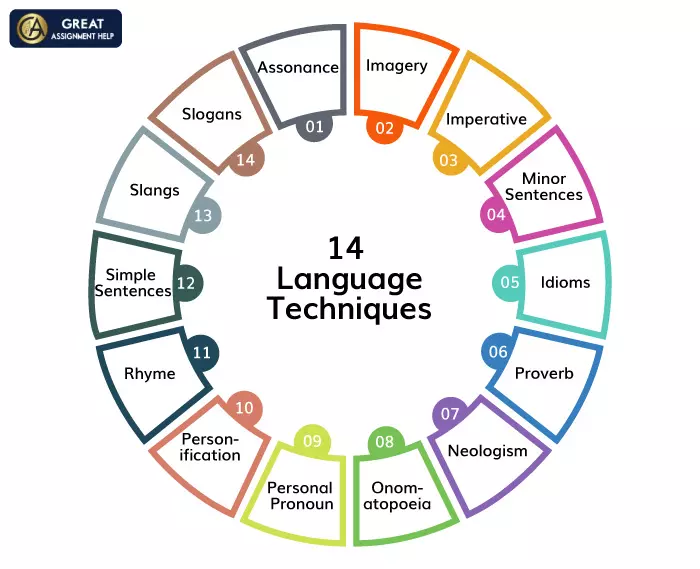If you want to elevate your writing, then try to implement language techniques such as metaphors, similes, alliteration, etc in your work. Especially, when you become an expert of using different language techniques, you can make your writing more engaging, expressive, and memorable, and effectively convey your message to your readers.
Writing is one of the best ways to communicate your opinions and ideas to others. While writing, to attract your readers, you can use language features and techniques. Basically, from composing a story to writing an assignment on language analysis or English literature, language techniques play a significant role in engaging the audience and making them understand the content in a better manner. In English, plenty of language techniques are available. Here, in this blog post, let us have a look at a few popular English language techniques with examples.
What is a Language Technique?
A language technique is a key element the writers use to highlight their themes when writing a story or an essay. It is commonly related to sentence structure, choice of words, tone, etc. Mainly, to make the readers understand their ideas, the writer uses language techniques. You can find a language technique anywhere in a story, novel, poem, or essay.
Some essential language techniques in English are Assonance, Idioms, Personification, Imagery, Proverb, Onomatopoeia, Imperative, etc.

Benefits of Using Language Techniques
Listed below are some major benefits of using English language techniques in academic writing.
- It helps to score well in assignment writing, story writing, poem writing, and novel writing.
- Adding different language features to assignments will make them impactful, irrespective of their kind. Moreover, it doesn’t matter if it’s a creative, transactional, or oral presentation, the language techniques will be beneficial for all.
- Simultaneously, the language techniques will help to achieve unit standards and critically analyze different texts. Also, it helps to analyze oral texts, poetic texts as well as transactions.
Significance of English Language Techniques
Language techniques are important because they help to
- Transfer thoughts into words
- Provide artistic meaning
- Give life to a story
- Build a logical framework with words and language
- Make the purpose of the story identifiable to the readers
- Evaluate how the readers understand a story
- Motivate both the reader’s and writer’s imagination
- Interpret the scenes in a story in the form of visuals
List of Essential English Language Techniques
Here is a list of the essential language techniques that everyone should know. For your better understanding, we have explained everything with examples. Take a look at it!

1. Assonance
Perhaps, it’s the vowel sound repetition that creates internal rhyming between sentences and phrases.
Example: “My brother spoke in a low mellow tone.”To illustrate, you may notice the repetition of the “o” vowel in the sentence, hence it applies assonance.
2. Imagery
Subsequently, imagery is another powerful language technique that proves advantageous for students. Moreover, it might help you to establish a scene or an image in the minds of your audience. Besides, this sensory impression might help you relate your tasks to them and thereby influence your audience.
Example: “The music was so moving that our whole body was trembling as if it emerged from within us.”
3. Imperative
Besides, we make use of the imperative language technique to give orders, warnings, commands, and instructions to the audience. Alternatively, if we have to request the audience, then we use words like “please”.
Examples
Sit down!
Come here!
Do not walk on the grass.
4. Minor Sentences
Perhaps, an irregular sentence is a minor sentence that comprises the following:
- Interjections
- Proverbs
- Idioms
- Single words
- Sentence fragments.
5. Idioms
Precisely, an idiom is a fixed expression or phrase that conveys a literal meaning on a few occasions or sounds figurative. Specifically, we use idioms, while speaking in a conversational language.
Example 1
A: “Hi, how are you?”
B: “Hey, John! Long time no see!”
Example 2
A: “How can you throw us out of our house like this?”
B: “Orders are orders.”
Moreover, an idiom is often understood and used in everyday language as well as speech. Also, they use the abbreviation and the audience needs to understand the complete phrase on their own.
Example
A: “I went through all the hurdles of getting her this job and still managed to screw it up.”
B: “Well, you can take a dog to the water.”
6. Proverb
Likewise, a proverb is also popular due to its frequent use and it’s broadly used by everyone. Besides, a proverb is a self-contained sentence because it communicates the truth based on shared experience and common sense.
Examples:
“You should try and form better habits in your day-to-day routine. Early to bed, early to rise, that sort of thing!”
“I’m not sure why people are shocked that he’s suspected of stealing. If the shoe fits.”
“Sure, bring your friends. The more, the merrier!”
7. Neologism
Have you heard of William Shakespeare? If yes, perhaps you know neologism because it was invented by Shakespeare only. Currently, a neologism is not used frequently, however, it was actively applied by Shakespeare. Let’s explore a few such words.
- Blushing
- Gnarled
- Cold-blooded
- Amazement
Examples
Butter: to give a long, rambling speech about uncertainty
Butter combines other words like blabber and stutter to create a new word with a new meaning.
8. Onomatopoeia
Perhaps, it’s a language technique that imitates the natural sound of a thing. Moreover, it develops a sound effect that imitates the object described. Hence, the description gets more interesting and expressive.
Example:
“The gushing stream flows in the forest.”
9. Personal Pronoun
Do you know what a personal pronoun is? Possibly, it’s a direct way to drive the reader’s attention and make the reader feel engaged as well as involved.
List of Pronouns
- My
- I
- We
- She
- You
- Me
- Our
- Her
- Him
10. Personification
“Raindrops danced on the pavement.”
What did you notice in this sentence? Possibly, you might have noticed that the raindrops were depicted dancing like a person. Thus, personification compares the qualities of a person to a non-living thing. In a nutshell, it adds life to a non-living thing.
11. Rhyme
To demonstrate, a rhyme is a replication of similar-sounding words, mostly in the last line of poems and songs. Moreover, it adds a pleasing impact to the poem. Furthermore, it showcases itself as a hinting device optimizing the advancement of memorization. Perhaps, the nursery rhymes we learned as children, might serve as the best example.
Example
“Baa baa black sheep, have you any wool?
Yes sir, yes sir, three bags full!
One for the master, one for the dame,
And one for the little boy who lives down the lane.”
12. Simple Sentences
Like any other language technique, a simple sentence also seems beneficial for you as a student. Moreover, it makes communication easier because of its conciseness and brevity. Perhaps, a simple sentence is the simplest technique to drive the reader’s attention, making it a famous language technique.
Example
The services are costly.
13. Slangs
Did you ever hear sub-standard words? Yes, slang is also a non-standard word, normally spoken to demonstrate inclusion in a specific social group.
Example
Last night was a flop. I was supposed to go to a party with my friends, but they flopped on me. They are all such floppers.”
14. Slogans
Perhaps, a catchy language technique that drives the reader’s attention, thus it uses striking, yet short phrases.
Examples
‘If you think education is expensive, try ignorance’ – Derek Bok (US educator and lawyer)
15. Oxymoron
An oxymoron is a popular figure of speech. It refers to the pairing of two contradictory words together. Using oxymorons, the writing can be enhanced. Also, it can be used to create humor and demonstrate linguistic skills.
Example:
I had a friendly fight with my sister.
Here, fight and friendly are two contradictory words. They are together formed to describe a passionate fight without hurting each other.
16. Euphemism
Euphemism refers to a mild or indirect word or expression that is substituted for one considered to be too harsh or blunt when referring to something embarrassing or unpleasant. It is used when a mild or “polite” expression is demonstrated by the speaker or writer instead of using a ‘vulgar’ or ‘blunt’ term.
Example:
We often say “passed away” instead of referring to death directly.
17. Juxtaposition
This is used when two things that are generally very opposite are placed next to each other, creating a stark contrast. Simply put, it is a literary device that places two things side-by-side for a contrasting effect.
Example:
It was the best of times, it was the worst of times.
Different Persuasive Language Techniques You Should Know
If you want your readers to believe what you say, then you must use several persuasive language strategies in your writing. Listed below are a few important persuasive language techniques that will help you enhance the quality of your writing.
- Provide answers to your audience: Readers are inundated with communications daily. Therefore, to capture readers’ attention, provide a convincing explanation with a clear aim. Make sure to present your answers for every “WHY” they may have.
- Pay attention to your tone: What you include in your writing is critical. However, the way you phrase it is even more important. Usually, the way you write affects how your reader will understand it. Also, it is crucial how the readers interpret your message. So, always use a pleasant and understanding tone. Never use a harsh tone. It is advisable to get to know the purpose of your writing initially and then decide to use an appropriate tone.
- Seek out the audience to establish a connection: Writers need a wide readership. Hence, it is critical to convince everyone. First, identify and write for the people who are most likely to benefit from your content. On the other side, continually strive to achieve better achievements. The audience that connects with your writing will value you more than those who do not.
- Employ language techniques to engage people: Language strategies can make your writing captivating to the readers. Moreover, if you employ these approaches, the audience will become more interested in your work. As a result, it will allow you to write in a variety of formats and styles. Remember, the public always admires a vibrant writer.
Conclusion
We hope you have now gained a better understanding of various English language techniques. Remember, if you have a good knowledge of language techniques, then you can effectively write your English assignments and effortlessly perform language analysis. Most importantly, using language techniques in assignment writing will also help you to get high scores. If it is troublesome for you to implement language techniques in your writing, approach us immediately. Our team contains several English experts to assist you in using appropriate language techniques in your tasks.



